|
Advantech VITA-350E
Enabling automatic vehicle location systems with rugged core technology
(by Conrad H. Blickenstorfer -- view PDF version)
GPS-Based Vehicle Tracking
When it comes to GPS, most people think of mapping and navigation, and perhaps of sports like geocaching. While those are the most popular uses, GPS also has other applications, and some of them are interesting for business as well as specialized commercial applications. For example, in conjunction with additional technology, GPS can be used for tracking vehicles both for personal and for business use.
The implications of this can be enormous. With GPS alone, you always know where you are on a map, and that is incredibly useful as evidenced by the fact that virtually every new car has GPS at least as an option. But a M2M (which stands for Machine-to-Machine) GPS tracking system goes well beyond that. It has the ability to let you know where a vehicle is at any given time even if you are not in it. How does it work?
A M2M GPS vehicle tracking device consists of a GPS receiver, some sort of voice/data cell phone, and a variety of sensors. The tracking device therefore...
- a) knows where it is,
- b) can call and/or transmit data,
- c) respond to calls and/or received data, and
- d) can perform certain actions in response to a call, to its location, or to a condition.
The diagram below shows how it all fits together:
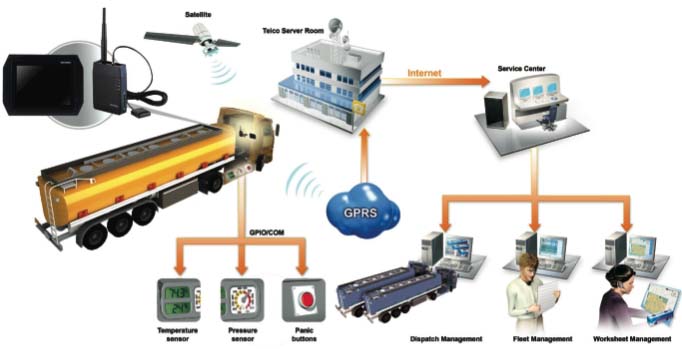
One use of GPS vehicle tracking systems is to adding safety and security to vehicles. You could, for example, program a "geofence" around the vehicle. If it is stolen, it will alert dispatch via call, email, or computer message as to its location. Such a system could serve as a very effective anti-theft measure as the vehicle's starter could be remotely disabled, its alarm triggered, or its doors locked. Employers could use it to track and enforce vehicle use. A web-based or local application could be used to show where the vehicle is, provide satellite photos of the location, report when geographic boundaries are exceeded, and also report current, average and top speeds. In addition, if someone gets locked out, the system could unlock the doors or start the engine.
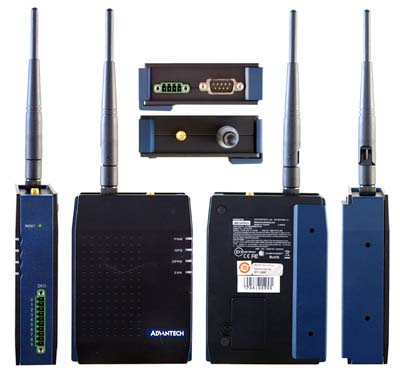 Other business uses of GPS vehicle tracking have even greater benefits. Intelligent fleet monitoring can revolutionize the way a business is run. In addition to theft protection, dispatcher and fleet management knows at any time where their vehicles are, what routes they have run, what the odometer reading is, and whether they are being used according to plan and policy. An advanced system may not only provide vehicle location on a map, geofences, remote alarms and door unlocking, but also detailed history reports that can show hourly usage, violations, speeding, or many other parameters. Other business uses of GPS vehicle tracking have even greater benefits. Intelligent fleet monitoring can revolutionize the way a business is run. In addition to theft protection, dispatcher and fleet management knows at any time where their vehicles are, what routes they have run, what the odometer reading is, and whether they are being used according to plan and policy. An advanced system may not only provide vehicle location on a map, geofences, remote alarms and door unlocking, but also detailed history reports that can show hourly usage, violations, speeding, or many other parameters.
The potential use of M2M GPS vehicle location systems is almost limitless. For example, special sensors could be used to retrieve information from the OBD-II onboard diagnostics system that has been mandatory in vehicles sold in the United States since 1996. OBD-II tracks dozens of vehicle functions, and that data could be used to provide fuel efficiency data, warn of potential vehicle and component failures or manage maintenance requirements.
If all this sounds enormously complicated, it's not. Installation of a GPS vehicle tracking system is inherently no more difficult than that of a car audio system. Setting up web-based tracking reports is simple as well, and can be done both for individual vehicles as well as for small and large fleets.
How much does it cost? That depends on the type and system as well as the software it comes with. Developers and systems integrators may use the rugged Advantech VITA-350E (shown from all sides in the picture above) to create simple or complex vehicle and fleet management systems. IT departments may build their own applications using Advantech tools and standard Windows development environments. VITA-350 based systems may be deployed as inhouse applications, or sold as turnkey or subscription-based systems.
GPS-based M2M systems are becoming increasingly popular as they easily pay for themselves with the theft protection and peace of mind they provide. They can also generate potentially dramatic savings and increased efficiency in commercial fleet management applications.
The Advantech VITA-350E Automatic Vehicle Location Device
Advantech is a global leading ePlatform services provider of web-based technology, computing platforms and customization services to facilitate innovations in what is an increasingly connected eWorld.
The VITA-350E is Advantech's M2M product for fleet management and similar automatic vehicle location (AVL) and location based services (LBS) applications. While those are probably the primary applications, the VITA-350E can also be used for data acquisition through GPRS, general wireless connectivity, remote access control, and device configuration. The VITA-350E is the part that is installed in the vehicle.
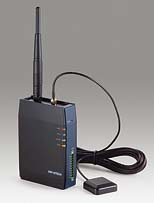 Physically, the VITA-350E is a small but very tough box (see picture to the left) measuring 3.5 x 4.8 x 1.1 inches and weighing just 13 ounces. Despite its small size, it is essentially a full Windows CE.NET 4.2-based computer incorporating a Siemens MC55 tri-band GSM/GPRS 900/1800/1900 wide area (celluar) radio module as well as an integrated high-sensitivity ublox ANTARIS 4 16-channel GPS receiver. The ANTARIS GPS engine supports a variety of the serial protocols used in GPS communication, among them NEMA, UBX and RTCM. The tiny Siemens MC55 wireless module is a full-fledged voice and GPRS Class 10 data communications solution with integrated TCP/IP stack that was designed specifically for M2M and other mobile applications. Physically, the VITA-350E is a small but very tough box (see picture to the left) measuring 3.5 x 4.8 x 1.1 inches and weighing just 13 ounces. Despite its small size, it is essentially a full Windows CE.NET 4.2-based computer incorporating a Siemens MC55 tri-band GSM/GPRS 900/1800/1900 wide area (celluar) radio module as well as an integrated high-sensitivity ublox ANTARIS 4 16-channel GPS receiver. The ANTARIS GPS engine supports a variety of the serial protocols used in GPS communication, among them NEMA, UBX and RTCM. The tiny Siemens MC55 wireless module is a full-fledged voice and GPRS Class 10 data communications solution with integrated TCP/IP stack that was designed specifically for M2M and other mobile applications.
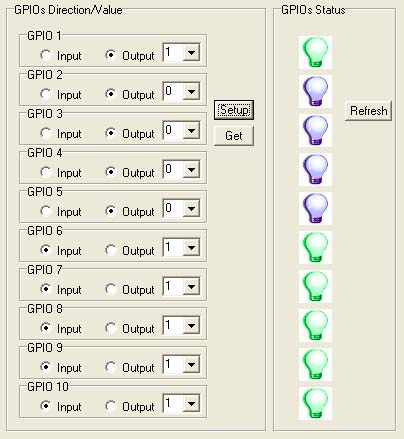 There are also ten digital GPIO channels with Phoenix-type connectors, and a 9-pin serial port for connection to a PC. The ten digital I/O channels can be used to monitor or control vehicle and other sensors and devices for a wide variety of data. By default, five are for input, five for output. However, the number of inputs and outputs can be divided as needed for an application (see control panel to the right). While data is usually communicated to the server in real time, the device also has a built-in 80MB Flash data logger. And while initial configuration may be via cable connection to a PC, it can also be remotely configured via GPRS connection. There are also ten digital GPIO channels with Phoenix-type connectors, and a 9-pin serial port for connection to a PC. The ten digital I/O channels can be used to monitor or control vehicle and other sensors and devices for a wide variety of data. By default, five are for input, five for output. However, the number of inputs and outputs can be divided as needed for an application (see control panel to the right). While data is usually communicated to the server in real time, the device also has a built-in 80MB Flash data logger. And while initial configuration may be via cable connection to a PC, it can also be remotely configured via GPRS connection.
The VITA-350E doesn't have a keyboard or display, but it has a bank of LED indicator lights to communicate operating status. Red, blue, green and orange LEDs indicate power status, GPS and GPRS activity, and error conditions. There are no expansion slots, but as a GSM/GPRS device, it has a SIM card compartment beneath a Philips screw secured cover.
The VITA-350E comes with a M2M utility that runs on a Windows XP PC or on a Windows CE device. The utility is used to manage M2M data, GPS functionality, and a variety of other parameters as well as add-on devices. You set the receiving server IP address, port and data formats, and the VITA-350E will then connect to the server and send GPS and/or I/O data. Physical connection between the VITA-350E and a PC a 9-pin null-modem female-to-female serial cable and defaults to COM3.
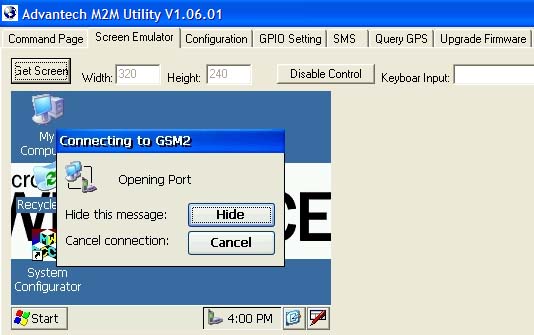 Since the VITA-350E is actually a full Windows CE device but one without display, the M2M software lets you run a screen emulation mode (see image to the right) through which you can control the device. It's a 320 x 240 display and not the first choice for configuring the VITA-350E, but you can control it that way, with the mouse on the PC. All functions of the VITA-350E Windows CE interface are available that way. Since the VITA-350E is actually a full Windows CE device but one without display, the M2M software lets you run a screen emulation mode (see image to the right) through which you can control the device. It's a 320 x 240 display and not the first choice for configuring the VITA-350E, but you can control it that way, with the mouse on the PC. All functions of the VITA-350E Windows CE interface are available that way.
Below is a screenshot of the M2M Utility that Advantech ships with the VITA-350E. As you can see, it is a comprehensive, tab-based configuration and setup utility that covers all aspects of the system. This is where you control the device, set the format for GPS data fields (there are almost 80), determine the status of the digital I/O lines, perform tests, query the GPS module, and lots more.
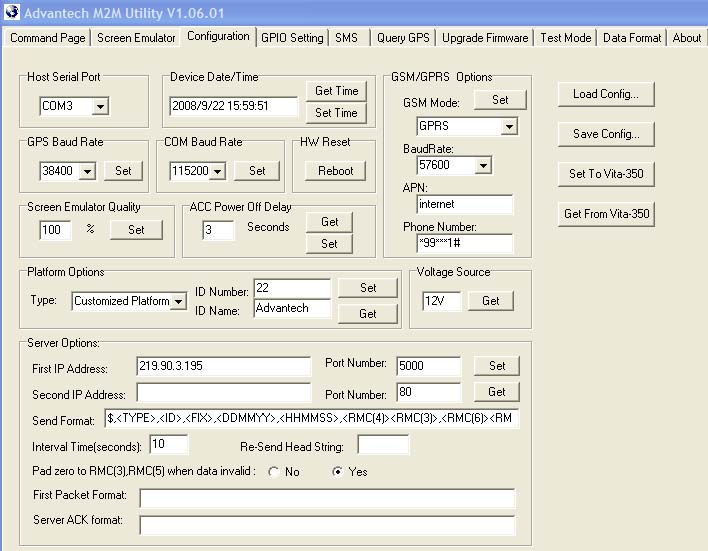
Since the VITA-350E must be able to operate in a vehicle, it is a rugged device built to survive vibration and extreme temperatures. Without any moving parts, shock and vibration isn't much of an issue and the VITA-350E passes MIL-STD-810F military level temperature, vibration and shock testing with ease. 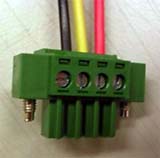 The very wide operating temperature range of the unit is 14 - 150 degrees Fahrenheit -- enough for almost any condition. The very wide operating temperature range of the unit is 14 - 150 degrees Fahrenheit -- enough for almost any condition.
In vehicles there are other ruggedness and operational considerations. Equipment may not cause electrical disturbances from coupling and conduction that could impact automotive electronic systems, and so Advantech designed the VITA-350E's DC power input to conform with ISO 7637 (see power plug to the right). Further, the VITA-350E, of course, carries all the requisite certifications from and/or compliance with FCC, UL, CE mark per the Radio and Telecommunications Terminal Equipment Directive (R&TTE), ETSI EN 301 489 (electromagnetic compatibility and radio spectrum Matters per) E-mark & NCC.
In summary, the Advantech VITA-350E device, when placed in a vehicle, knows its location through its integrated GPS receiver. It then communicates that GPS data, as well as other data collected through its digital I/O ports, to a central dispatch via an integrated cellular data module,. This enables the dispatch to track the vehicle or even take manual or automatic action. The potential of this technology is tremendous.
-- Conrad H. Blickenstorfer
Advantech VITA-350E Specs:
| Type |
Automatic vehicle location device
|
| Processor |
XScale RISC
|
| OS |
Windows CE .NET 4.2
|
| GPS |
16-channel ANTARIS 4 supporting NEMA, UBX and RTCM serial protocols, 6-8 foot accuracy |
| GSM/GPRS |
Siemens MC55 tri-band GSM/GPRS 900/1800/1900 wide area radio; GPRS Class 10 data communications, integrated TCP/IP stack |
| Memory |
Standard Windows CE-style RAM/ROM configuration |
| Display |
Use TREK-305R or similar (screen emulator available via utility);
|
| Keyboard |
provided via emulation |
| Expansion/card slots slots |
1 SIM (+3V)
|
| Housing |
Plastic |
| Size |
3.5 x 4.8 x 1.1 inches |
| Weight |
12 ounces
|
| Operating temperature |
14 - 150 degrees Fahrenheit |
| Humidity |
5-85% |
| Vibration and shock |
MIL-STD-810F |
| Power |
+12V/+24V vehicle DC per ISO-7637 |
| Interface |
1 9-pin RS-232, 10 digital I/O, power, GPRS antenna (standard female reverse SMA) |
| Wireless |
GPS, GSM/GPRS
|
| Certifications |
FCC, UL, CE : R&TTE, ETSI EN 301489 E-mark & NCC |
| Price |
depends on configuration |
| Contact |
Advantech www.advantech.com.tw |
Advantech Corporation
38 Tesla, Suite 100
Irvine, CA 92618
Toll Free: 1-800-866-6008
Ph: 949-789-7178
Fax: 949-789-7179
ECGInfo@advantech.com
www.advantech.com
Advantech Co. Ltd.
No.1, Alley 20, Lane 26, Rueiguang Road
Neihu District, Taipei Taiwan 114, R.O.C.
Tel: 886-2-2792-7818
Fax: 886-2-2794-7301
www.advantech.com
|



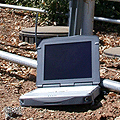

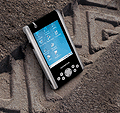
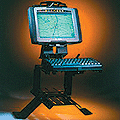






 Other business uses of GPS vehicle tracking have even greater benefits. Intelligent fleet monitoring can revolutionize the way a business is run. In addition to theft protection, dispatcher and fleet management knows at any time where their vehicles are, what routes they have run, what the odometer reading is, and whether they are being used according to plan and policy. An advanced system may not only provide vehicle location on a map, geofences, remote alarms and door unlocking, but also detailed history reports that can show hourly usage, violations, speeding, or many other parameters.
Other business uses of GPS vehicle tracking have even greater benefits. Intelligent fleet monitoring can revolutionize the way a business is run. In addition to theft protection, dispatcher and fleet management knows at any time where their vehicles are, what routes they have run, what the odometer reading is, and whether they are being used according to plan and policy. An advanced system may not only provide vehicle location on a map, geofences, remote alarms and door unlocking, but also detailed history reports that can show hourly usage, violations, speeding, or many other parameters.
 Physically, the VITA-350E is a small but very tough box (see picture to the left) measuring 3.5 x 4.8 x 1.1 inches and weighing just 13 ounces. Despite its small size, it is essentially a full Windows CE.NET 4.2-based computer incorporating a Siemens MC55 tri-band GSM/GPRS 900/1800/1900 wide area (celluar) radio module as well as an integrated high-sensitivity ublox ANTARIS 4 16-channel GPS receiver. The ANTARIS GPS engine supports a variety of the serial protocols used in GPS communication, among them NEMA, UBX and RTCM. The tiny Siemens MC55 wireless module is a full-fledged voice and GPRS Class 10 data communications solution with integrated TCP/IP stack that was designed specifically for M2M and other mobile applications.
Physically, the VITA-350E is a small but very tough box (see picture to the left) measuring 3.5 x 4.8 x 1.1 inches and weighing just 13 ounces. Despite its small size, it is essentially a full Windows CE.NET 4.2-based computer incorporating a Siemens MC55 tri-band GSM/GPRS 900/1800/1900 wide area (celluar) radio module as well as an integrated high-sensitivity ublox ANTARIS 4 16-channel GPS receiver. The ANTARIS GPS engine supports a variety of the serial protocols used in GPS communication, among them NEMA, UBX and RTCM. The tiny Siemens MC55 wireless module is a full-fledged voice and GPRS Class 10 data communications solution with integrated TCP/IP stack that was designed specifically for M2M and other mobile applications.
 There are also ten digital GPIO channels with Phoenix-type connectors, and a 9-pin serial port for connection to a PC. The ten digital I/O channels can be used to monitor or control vehicle and other sensors and devices for a wide variety of data. By default, five are for input, five for output. However, the number of inputs and outputs can be divided as needed for an application (see control panel to the right). While data is usually communicated to the server in real time, the device also has a built-in 80MB Flash data logger. And while initial configuration may be via cable connection to a PC, it can also be remotely configured via GPRS connection.
There are also ten digital GPIO channels with Phoenix-type connectors, and a 9-pin serial port for connection to a PC. The ten digital I/O channels can be used to monitor or control vehicle and other sensors and devices for a wide variety of data. By default, five are for input, five for output. However, the number of inputs and outputs can be divided as needed for an application (see control panel to the right). While data is usually communicated to the server in real time, the device also has a built-in 80MB Flash data logger. And while initial configuration may be via cable connection to a PC, it can also be remotely configured via GPRS connection.
 Since the VITA-350E is actually a full Windows CE device but one without display, the M2M software lets you run a screen emulation mode (see image to the right) through which you can control the device. It's a 320 x 240 display and not the first choice for configuring the VITA-350E, but you can control it that way, with the mouse on the PC. All functions of the VITA-350E Windows CE interface are available that way.
Since the VITA-350E is actually a full Windows CE device but one without display, the M2M software lets you run a screen emulation mode (see image to the right) through which you can control the device. It's a 320 x 240 display and not the first choice for configuring the VITA-350E, but you can control it that way, with the mouse on the PC. All functions of the VITA-350E Windows CE interface are available that way.

 The very wide operating temperature range of the unit is 14 - 150 degrees Fahrenheit -- enough for almost any condition.
The very wide operating temperature range of the unit is 14 - 150 degrees Fahrenheit -- enough for almost any condition.